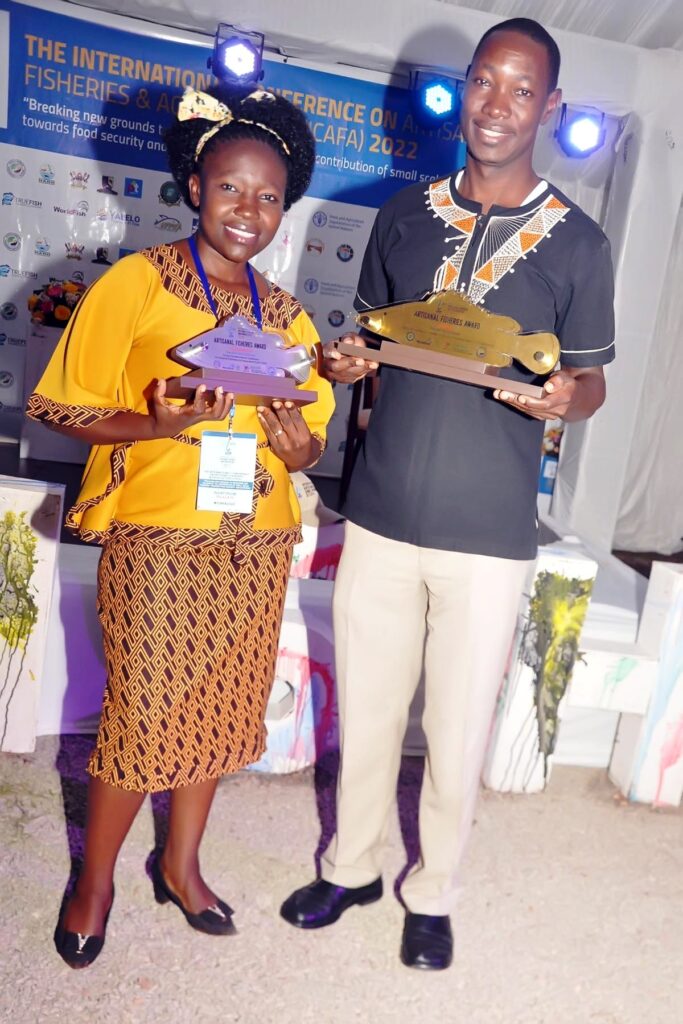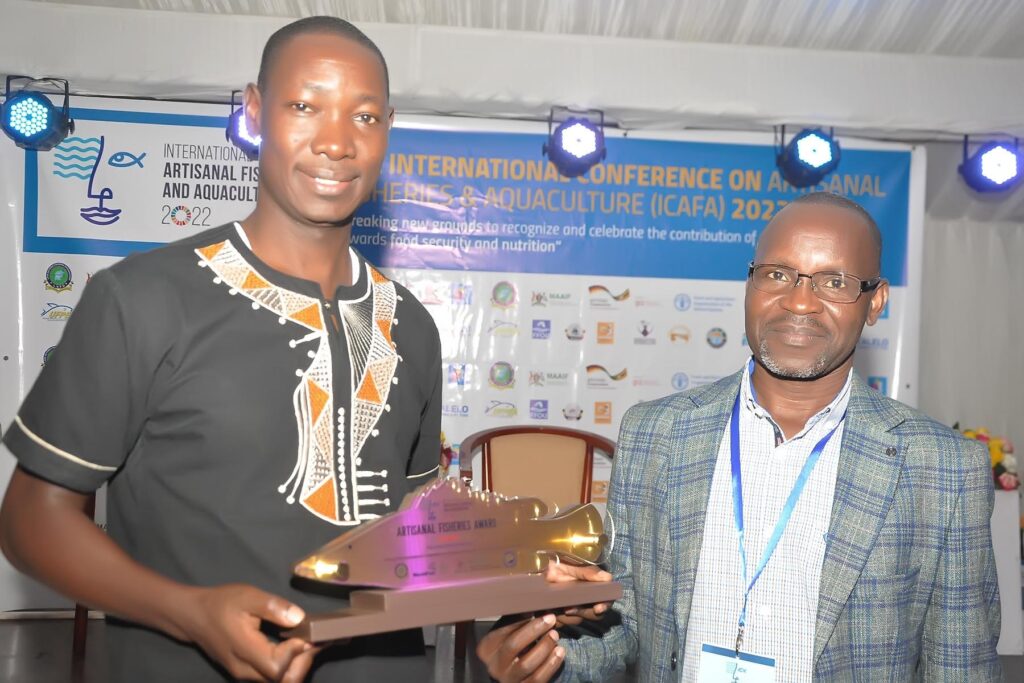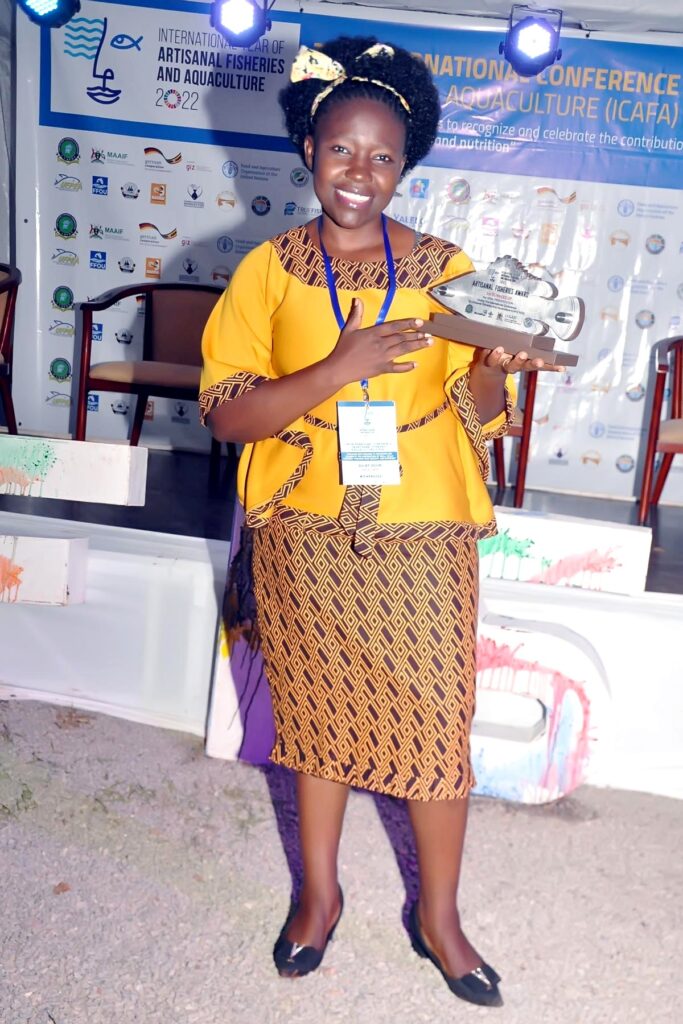Two of the NutriFish-sponsored PhD students, Nakiyende Herbert and Julliet Nafula Ogubi won the awards for the best and second-best oral presentations in the young scientists’ category at the International Conference on Artisanal Fisheries and Aquaculture (ICAFA) held in Jinja, Uganda from 1st-3rd September 2022.
The conference was organized under the theme “Breaking new grounds to recognize and celebrate the contribution of small-scale fisheries towards food security and nutrition”.
Supported by the International Research Development Centre (IDRC) and the Australian Centre for International Agricultural Research (ACIAR) through their joint programme, Cultivate Africa’s Future Fund (CultiAF), NutriFish aims to address the nutritional needs of vulnerable groups that cannot afford expensive commercial fish but are in critical need of high-quality nutritious diets.

The Project is coordinated by Dr Jackson Efitre, Senior Lecturer in the Department of Zoology, Entomology and Fisheries Sciences, College of Natural Sciences (CoNAS), Makerere University.
The title for Nakiyende Herbert’s presentation was: “Are small pelagic fisheries a blessing or curse? Understanding fisher community perceptions towards light fishing on Lake Albert, Uganda”.
Light fishing, the technique of catching fish by light attraction was introduced to Lake Albert, Uganda around early 2000s, to target two small pelagic species (SPS), Engraulicypris bredoi (muziri) and Brycinus nurse (ragoogi).
The introduction of light fishing coincided with a period when stocks of large-bodied fishes, such as Tilapia spp, Lates niloticus, Bagras bajad, Alestes baremose, and Hydrocynus forskahlii in the Ugandan waters of Lake Albert had started to decline. Although Lake Albert is shared by Uganda and the Democratic Republic of Congo (DRC), light fishing is prohibited in DRC waters.

This study evaluated the socio-ecological consequences of light fishing on the fisheries and lakeside communities of Lake Albert in Uganda, to inform sustainable management. Data was collected in April 2021 from three landing sites (Ntoroko, Kaiso, and Dei), through semi-structured interviews and focus group discussions. Light fishing has transformed the lake’s annual fish catch from < 60,000 tonnes (t) in the early 2000s, mainly of large species to about 330,000 t, dominated by SPS (60 – 80%) by 2021.
The SPS light fishery currently engages over 30% of total fishing boats and 60% of fishers in the Ugandan waters of the lake. The technique has also led to conflicts with fishers targeting the large-bodied species, the main concerns being: i) excessive light fishing effort; ii) competition for fishing grounds; iii) high by-catch (~10%) dominated by juveniles of the large species; and iv) destruction of passive fishing gears used in the large-bodied species fisheries.
To ensure co-existence in the multi-species fishery and continued livelihood benefits (employment, income, and food) of the SPS light fishery, resting and closed periods and light-fishery effort control were proposed by 95.4% of respondents. Detailed scientific investigation of the light fishing methods is recommended, to guide on the proposed closed season and fishing effort controls.
Julliet Nafula Ogubi’s presentation was on: “Spoilage mechanisms and associated drivers in post-harvest loss management in freshwater small pelagic fishes in Africa”.
Small pelagic fishes (SPFs) are steadily being recognized for their contribution to livelihoods, food and nutritional security, especially in developing countries. The SPFs are schooling fishes with a total length of 20 cm, preserved mainly by open sun-drying. Despite the bulk harvests, post-harvest losses associated with spoilage continue to hamper their availability, accessibility and consumption.

A review of available literature on similar marine species revealed that spoilage commences immediately after harvest and progresses through three cascading but overlapping processes: autolytic (enzymatic), microbial and chemical reactions causing physical, quality, nutritional and economic losses.
Spoilage in SPF is accelerated by i) their large surface-to-volume ratio; ii) the reliance on fluctuating sun radiation for drying which depends on prevailing weather conditions; c) limited drying spaces for large quantities landed. With regard to the magnitude of losses, spoilage-related quality deterioration and nutritional changes in fish are rarely evaluated, hence associated economic value is lacking.
The magnitude of losses attributed directly to the spoilage mechanisms has not been determined in freshwater SPFs, yet cost-effective interventions target significant processes. Handling practices, especially stacking and mixing of different fish hauls as drivers of spoilage mechanisms have not also been evaluated. In addition, the effect of prolonged trips and lack of controlled temperature on-board, are less understood.
Therefore, an urgent in-depth assessment of quality and nutritional losses and the associated economic value; the contribution of each spoilage mechanism to the magnitude of losses and the effect of handling practices on the rate of spoilage among freshwater SPFs is needed.
Source: Makerere University











